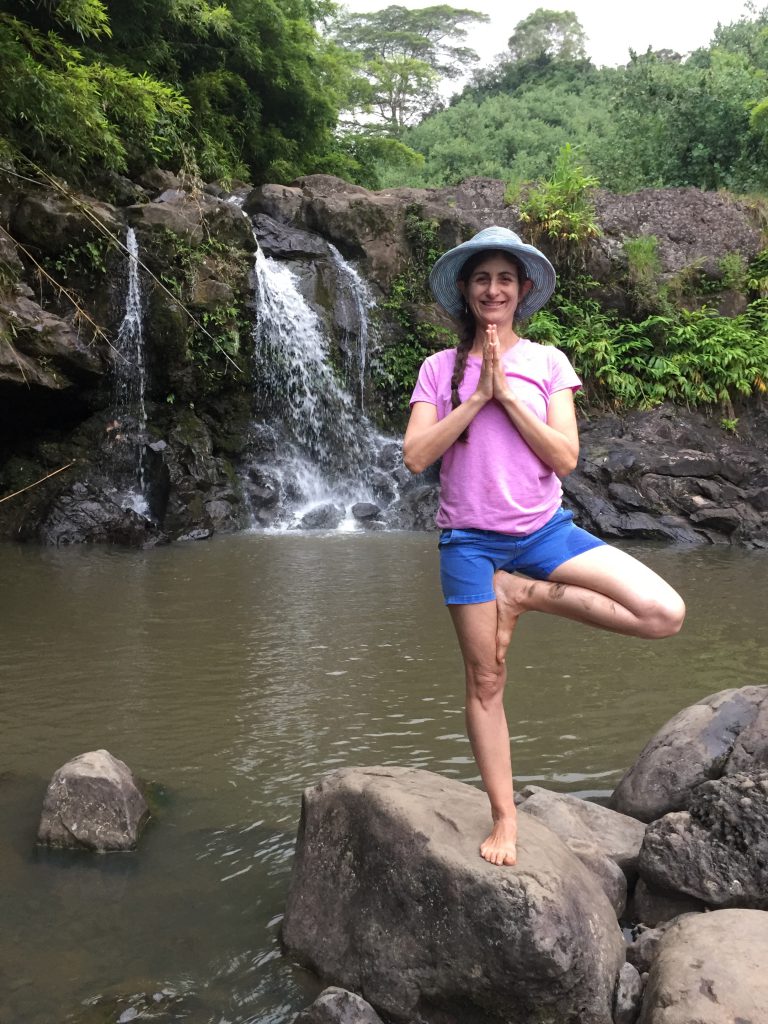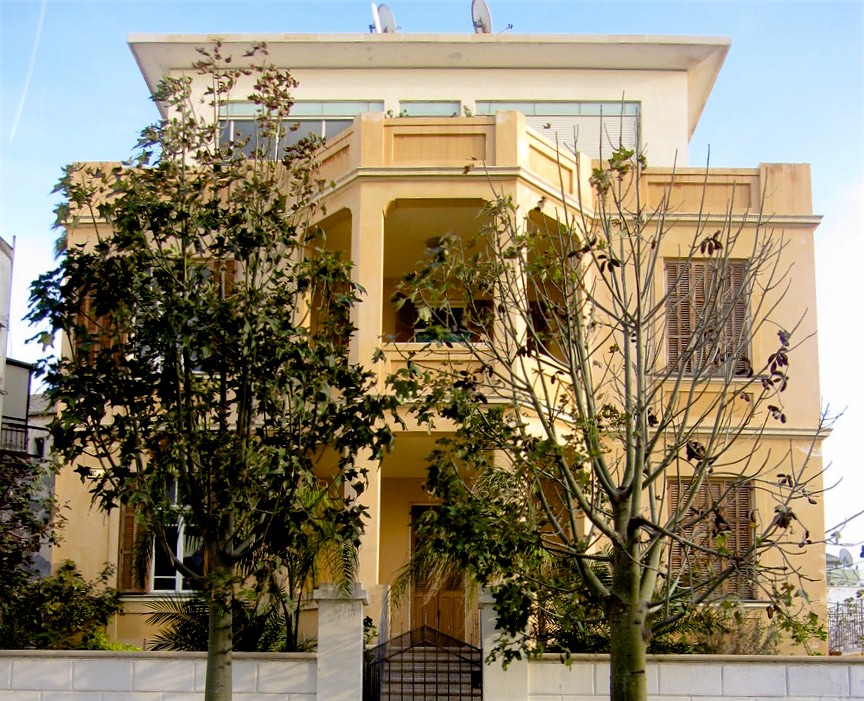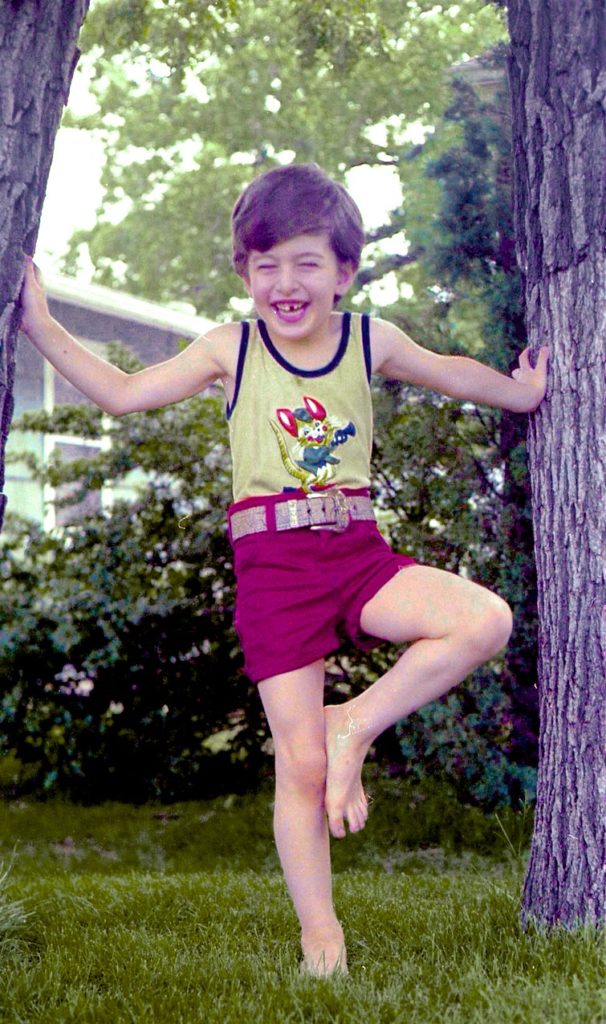
Tree pose – Vrksasana is a pose that’s often taught to beginners and like many beginning poses, has many facets that are further revealed with practice. Practicing this pose sometimes brings up vivid memories. My recollections are tied to different times in my life and different places I’ve lived. Below I share a few of these memories and then discuss the physical aspects of the pose.

When I was a young girl I would visit my grandmother who lived in a old section of Tel-Aviv. Her two room apartment was a part of what had originally been a large villa built during the time of the British mandate of Palestine. By the 1970’s the plastered walls were peeling and the bullet holes from the 1940’s were part of the historical charm of the building. I distinctly remember the first time I walked up the grand fanning staircase at the entrance. There was a sweet fragrance that I had never smelled before. I continued up the stairs and toward the top saw a tree with bright yellow 5-petaled flowers. Having grown up in Minnesota, I had never seen a tree with bouquets of fragrant flowers. The tree had shiny smooth leaves and bark that looked a little like an elephant’s skin.

I remember walking over to the tree and sticking my nose into the flowers. I breathed deeply and took in the most fragrant scent I had ever experienced. To this day, I still can feel that breath.
I looked around the yard and neighborhood for other trees like it, but never found one in the whole city of Tel-Aviv. When I was a teen, I finally came across a tree that seemed to be the mother of the one in Tel-Aviv. It was in the North of Israel, on Kibbutz Beit Alpha. I spent a summer there as a volunteer painting tree trunks to protect them from bugs and making special food for people with dietary restrictions. The tree was strong and sturdy. It provided a canopy over a grassy area in front of the dining hall. I used to spend my time off playing the piano indoors and then I would sit under the shade of the tree, breathe in its sweet scent and eat freshly baked bread that was soft and fluffy.
I asked around but no one could tell me where the tree came from or what it was called. For years, the memories of those trees flitted on the edge of my consciousness.
Decades later, I visited Hawaii for the first time. The moment I got off the plane and walked out of the air conditioned corridor, I was struck by that same sweet smell. As I walked along the hallway, I saw a courtyard full of those trees. I took a deep breath and felt a sense of home.
Today I know that the tree with the luscious scent has a few names. In the Pacific, it’s called plumeria. In the Caribbean its known as Frangipane. There are a number of species and they are thought to have originated in Central or South America but now have a presence throughout the world, especially in tropical regions of Asia. Plumeria flowers are commonly used for adornment and in the making of leis. Living in Hawaii, I am literally surrounded by this beloved tree. There is one on each side of the my cottage. Whenever I catch a waft of their scent, it brings me back to my grandmother’s apartment.

Do you have a special memory of a tree or of the experience of tree pose? If so, I’d love to hear about it.
I have a delightful picture of my brother standing next to a tree in a variation of tree pose when he was about 5 years old. Neither of us had been exposed to yoga at that time. We just liked to play in the yard.
The first time I experienced tree pose as a defined yoga posture was at the Berkeley YMCA. I remember feeling proud that I was able to balance. I thought that was the point of the pose. Little did I know, it had infinite components, a few of which I will share below.
Tree pose is a fun challenge. It’s also a good diagnostic about the state of one’s balance on a particular day. You may find that some days its easy to stay upright and some days one topples immediately. You may also find that it’s much easier to balance on one leg than the other.
Over the years, I have heard many people say that they can’t do tree pose because their pants are too slippery. I always laugh. It’s true that slippery material can make it more challenging, but there are other physical reasons that one’s foot can’t remain steady on the opposite leg. It’s more about one’s legs than the fabric.
The ability to stand steady as a tree is made up of many components including, Hip Mobility, Leg Foldability (a new word for explaining the ability to bend the knee and fold the calf and thigh toward each other), Gluteal Engagement, Foot Dexterity and Ankle Strength. Developing each of these components leads to better balance. Below I share a bit about each.
Hip Mobility
Hip mobility is the ability to move the femur (thigh bone) in the pelvis. The thigh bone is the largest joint in our body and there are two main components to its ability to move: bone and soft tissue. The structure of the thigh bone and hip socket has a significant effect on hip mobility. This shape is based on a host of factors including genetics and lifetime habits. (See Well-Intentioned Intrusion). With a great deal of concentrated effort, the shapes of the bones and how they fit together can be changed over a long period of time. The soft tissues of the hip are more malleable.
Tree pose requires one specific aspect of hip mobility; a significant degree of external rotation of the thigh. One of the main challenges that practitioners experience when externally rotating the thigh is keeping the pelvis steady. this requires concentration and attention as it is easy to swing the pelvis to the side when rotating the hip.
When I first started practicing yoga, I thought that I had to align my body to an idealized shape. With tree pose, I thought this meant that my thigh should be at a 90 degree angle with my pelvis. I mention this because I think it is a common assumption and the reason so many people torque the pelvis in this pose. Today I focus on keeping the pelvis steady, specifically the hip points (ASIS) facing forward while rotating the thigh.
Leg Foldability
The ability to fold one’s leg is the greatest hidden factor in the ability to practice tree pose. By this I mean the ability to bring the thigh and the calf together by bending the knee. Like the rotation of the thigh, this is a multi-factorial movement. One of the quickest ways to increase the fold of the leg is to do practices that release the calf such as Calf Stretch, Demuckousana and Supta Pandangusthasana. If one cannot do this fold, it is impossible to place the foot on the thigh. While one can do tree pose with the foot lower on the leg, it is more difficult to balance. A key component of balancing in tree pose is to press the bent knee foot into the opposite thigh. If the leg cannot be brought up to thigh height, one cannot benefit from the mutual compression of the foot into the thigh which helps facilitate balance. There is also a stronger center of gravity when the leg is higher.
Gluteal Engagement
Gluteal Engagement is an overlooked factors in standing balance. The gluteus medius muscles, which are on the side of each hip, are a key factor in standing and walking. People in chair-sitting societies tend to be very weak in this area. Many suffer from a kind of gluteal amnesia where these muscles are rarely engaged and over time atrophy. Hip Lists and Hip Circles are a good way to fight this scourge and develop better balance. You can read more about glute strength in the blog post Tricky Trikonasana.
Foot Dexterity and Ankle Strength deserve a blog post (or a book) of their own. In short, the more mobile ones feet, the easier it is to balance on the standing leg and easier to place the foot of the bent leg onto the opposite thigh. I recommend that you play with your feet and introduce them to a variety of surfaces to keep them agile. The play with your feet and ankle circle videos are a good place to start.
Getting all these parts to work together will definitely benefit your experience of tree pose. It will also allow you to wear slippery pants to yoga class while being able to more easily balance.
Here’s some instructions for how to come into tree pose:
Find mountain pose and remember to not stand like a banana. Bend one knee and externally rotate the thigh while keeping the pelvis steady. In other words, keep your hip points (ASIS) facing forward. Then check the outer hip (gluteus medius) of the standing leg. Do not sink into the pose like Olivia Newton John in Grease. (1:04 in this video). Instead, engage that side hip muscle as a stabilizer for balance.
Then lift your leg while simultaneously folding the calf and hamstring toward each other. Press the sole of your foot into your standing leg and press the standing leg laterally back into the foot. This mutual pressure is a key to being able to sustain one’s balance.
Alternatively, first fold the thigh, bring the folded thigh upward and then externally rotate the leg before placing the foot on the thigh.
Chose a hand position that is appropriate for you. Classic hand positions are palms together over the heart or arms overhead. If you want an additional challenge, move the arms around like branches in the wind. You can also challenge your visual and vestibular systems by closing your eyes and/or moving your head in different directions. Another option is to stand on a slope or a taller surface than you are used to.
Along with these bio-mechanical instructions, it is important to point out there are neuro-centric aspects to balance that are more tied to the visual and vestibular systems. I hope to share more about this in future blog posts and short videos.
Trees are life giving and life affirming. As you practice the physical aspects of Tree Pose, may you feel the flow of the life force coursing through your branches.

